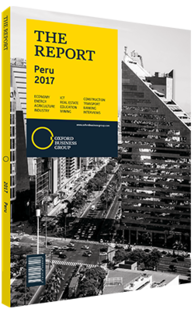Eduardo Morón, President, the Peruvian Association of Insurance Companies: Interview

Interview: Eduardo Morón
What challenges are posed by the new law allowing affiliates of pension fund administrators to withdraw 95.5% of their funds at 65 years old?
EDUARDO MORÓN: The measure has resulted in thousands of affiliates withdrawing their funds after retiring. However, it is worth noting that because the pensions being withdrawn average PEN20,000 ($5928) per person this is not yet an alarming trend. This is due to the fact that the pension fund system was only created 25 years ago, therefore the amount of affiliates that were able to save large amounts in such a short period of time is relatively limited. What should worry the sector, however, is the fact that many Peruvians who have the resources to buy a pension plan opt out. In fact, only 5% of affiliates acquire a life annuity with their pension fund.
In order to avoid a mass withdrawal of pension funds – which could possibly result in the collapse of the pension fund system itself – there is one key step that can be taken to address the issue: amending the law so that affiliates intending to withdraw their funds return the withdrawn amount within a certain period of time if the funds are not being used as a pension. Taking into account that the law was an extremely popular measure when passed in 2016, abolishing the law would only hurt the sector and be a politically irresponsible move.
How can insurance penetration be increased among small and medium-sized enterprises?
MORÓN: It is important to understand that the liberalisation of the insurance sector 25 years ago has not enhanced the reach of insurers. In fact, it is safe to state that it is mainly the same top layers of the private sector receiving coverage today as 25 years ago. While the number of insured businesses has certainly increased, they would mostly be categorised as segment A and B companies. This is mainly due to the country’s 70% informality rate. One cannot deny the fact that many companies are insured simply because there are certain types of insurance products required by all businesses. Therefore, high levels of informality hamper insurance penetration efforts.
Additionally, insurers have not developed adequate channels to appeal to the country’s informal economy. Nevertheless, one can expect the sector to take a different approach by redesigning its channels, with the goal of penetrating lower segments of the business landscape and capitalising on the growth of the middle class and its purchasing power.
What impact has El Niño had on insurers, and how might it effect the development of the industry? What role can private insurers play?
MORÓN: The El Niño phenomenon had a much less significant impact on insurers than was anticipated. However, it served to showcase the essential role that the insurance sector could play in protecting Peruvian agriculture from changes in climate and weather patterns by exposing the lack of coverage and potential economic losses associated with it. In fact, what is clear is that the private and public sectors are not adequately prepared to mitigate recurrent natural phenomena such as El Niño and earthquakes. It became evident that only one in three homes in Peru is insured against natural disasters, even in areas such as Tumbes or Piura, which are periodically exposed to the inclemency of El Niño. In light of this absence of coverage in agriculture, it becomes obvious that there is a need for the creation of a government subsidy that allows farmers to prepare for any impact that El Niño or other natural phenomena might have on their crops.
The role of the private sector is to bring the know-how that ultimately minimises the losses associated with El Niño, while the public sector should act as an enabler by creating the necessary framework that encourages insurers to invest in rural areas.
You have reached the limit of premium articles you can view for free.
Choose from the options below to purchase print or digital editions of our Reports. You can also purchase a website subscription giving you unlimited access to all of our Reports online for 12 months.
If you have already purchased this Report or have a website subscription, please login to continue.

